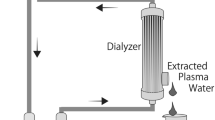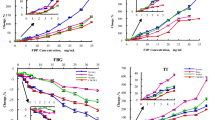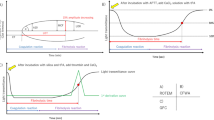Abstract
IMMUNOLOGICAL methods have been used to estimate the levels of fibrinogen and fibrin degradation products in serum samples during thrombolytic therapy and in various clinical situations. A recent report1 has suggested that methods such as the tanned red blood cell haemagglutination inhibition immunoassay2 and latex aggregation3 measure mainly the products of fibrin degradation. We wish to report on techniques which have proved useful in differentiating between the degradation products of fibrinogen and fibrin clots in whole plasma systems in vitro and which have helped in confirming results obtained4,5 using purified fibrinogen and fibrin clots.
This is a preview of subscription content, access via your institution
Access options
Subscribe to this journal
Receive 51 print issues and online access
$199.00 per year
only $3.90 per issue
Buy this article
- Purchase on Springer Link
- Instant access to full article PDF
Prices may be subject to local taxes which are calculated during checkout
Similar content being viewed by others
References
Gallimore, M. J., Tyler, H. M., and Shaw, J. T. B., J. Clin. Path., 25, 185 (1972).
Merskey, C., Lazezari, P., and Johnson, A. J., Proc. Soc. Exp. Biol. Med., 131, 871 (1969).
Ferreira, H. C., and Murat, L. G., Br. J. Haematol., 9, 299 (1963).
Gaffney, P. J., and Brasher, M., Biochim. Biophys. Acta, 295, 308 (1973).
Gaffney, P. J., Fibrinogen and its Derivatives Symp., Warsaw, 1972. Thrombosis Research (in the press).
Weber, K., and Osborn, M., J. Biol. Chem., 244, 4406 (1969).
McFarlane, A. S., J. Clin. Invest., 42, 346 (1963).
Nussenzweig, V., Seligman, M., Pelmont, J., and Graber, P., Ann. Inst. Pasteur, 100, 377 (1961).
Jamieson, G. A., and Gaffney, P. J., Biochim. Biophys. Acta, 154, 96 (1968).
Marder, V. J., Shulman, N. R., and Carroll, W. R., J. Biol Chem., 244, 2111 (1969).
Budzynski, A. Z., Stahl, M., Kopec, M., Latallo, Z. S., Wegrzynowicz, Z., and Kowalski, E., Biochim. Biophys. Acta, 147, 313 (1967).
Gaffney, P. J., and Dobos, P., FEBS Lett., 15, 13 (1971).
McDonagh, R. P., jun., McDonagh, J., and Duckert, F., Br. J. Haematol., 21, 323 (1971).
Finlayson, J. S., and Morton, R. O., Clin. Chim. Acta, 36, 254 (1972).
Gaffney, P. J., Nature new Biol., 234, 281 (1971).
Tillett, W. S., and Garner, R. L., J. Exp. Med., 58, 485 (1933).
Chesterman, C., Allington, M., and Sharp, A., Nature new Biol., 238, 15 (1972).
Author information
Authors and Affiliations
Rights and permissions
About this article
Cite this article
GAFFNEY, P., BRASHER, M. Methods of Examining Fibrinolysis in Plasma. Nature 244, 361–362 (1973). https://doi.org/10.1038/244361a0
Received:
Revised:
Issue Date:
DOI: https://doi.org/10.1038/244361a0
This article is cited by
-
Mode of action of ancrod as a defibrinating agent
Nature (1974)
Comments
By submitting a comment you agree to abide by our Terms and Community Guidelines. If you find something abusive or that does not comply with our terms or guidelines please flag it as inappropriate.



